[ad_1]
The Diamond Goby is a peaceful reef fish that will liven up your tank with a subtle burst of color (spots) and personality. They are a reasonably hardy species of fish that should be easy for beginners or advanced hobbyists to care for–and watching them dig through and sift the sand like a prospector is loads of fun to watch. This article will share some more interesting facts about the Diamond Watchman Goby and how to care for it in a saltwater aquarium.
Table of contents
This article is broken down into the following subtopics around Diamond goby care. You can use the links below to jump down to a specific section.
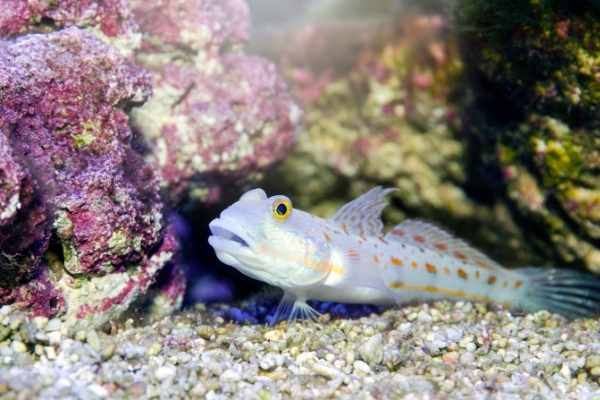
The Diamond Goby is a great, sand-sifting saltwater fish with a cool personality
A few quick facts about the Diamond Goby:
- Scientific Name: Valenciennea Puellaris
- Common Names: Diamond Goby, Diamond Watchman Goby, Orange Spotted Goby, Diamond Sleeper goby (these names will be used interchangeably in this article
- Max Size: 6-Inches
- Minimum Tank Size: 20-gallons (long)
- Aggression Level: Peaceful
- Color: White, Orange, Yellow
- Care Level: Easy and suitable for beginners
- Most Active: Day
- Lifespan: 5 to 8 years in captivity could be expected (please leave a comment at the bottom of this article to share your own experiences)
- Diet: Meaty foods (carnivorous)
- Price: ~$30-$45 range
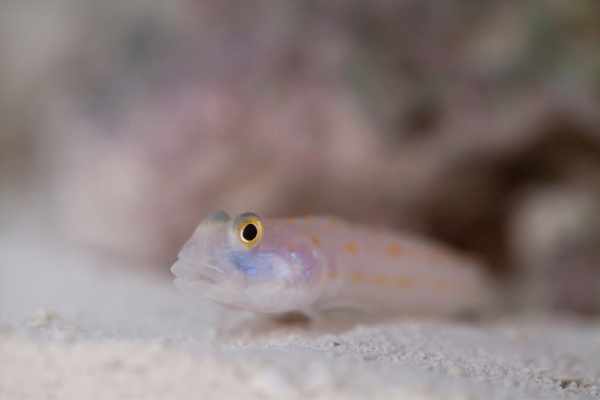
Note the big eyes of the Diamond Watchman Goby
Natural habitat
The Diamond Watchman Goby is a sand sifter and spends a lot of their time gulping in mouthfuls of sand and raking through it for tiny morsels of food. They suck the sand in through their mouths and then expel it out their gills. It’s fun to watch.
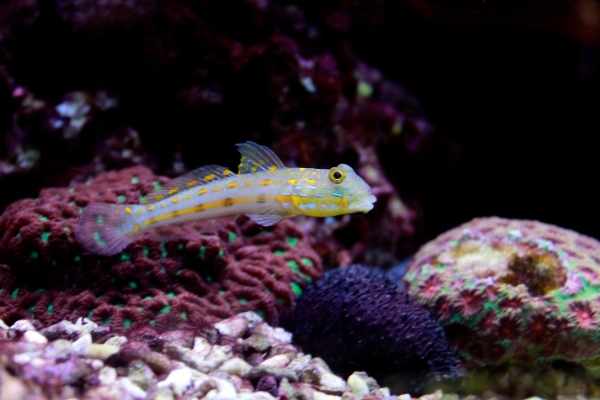
Note how the Orange spotted goby gets its name
Aquarium care guide
The Diamond Goby is a medium-sized fish. 6-inches is the fully grown length, but they are a relatively compact, torpedo-shaped 6-inches. They will dig out a burrow under the live rock and will stay on or close to the sand, sucking in and sifting the occasional mouthful of sand.
Minimum tank size for the Diamond Watchman Goby
At about 6-inches in length, when fully grown, they are a medium-to-large sized saltwater fish, but since they are relatively substrate attached, they can be kept in a 20-gallon long-style tank, which is 30-inches x 12-inches (76 centimeters x 30.5 centimeters. If you have more sand-dwellers than that in your tank (Engineer gobies, jawfish, etc.) you probably want a minimum tank size that is twice that size and should probably use caution because you may end up with some aggression and fighting.
Substrate and structure suitable for the Orange Spotted Goby
Since they are burrow-digging sand sifters by nature, perhaps the most important element to the healthy, natural care of the Diamond Goby is to have a deep sand bed (DSB) suitable for being sifted through. It is possible to keep them in a bare-bottomed tank, but it would be unnatural for you and the fish…so…why bother.
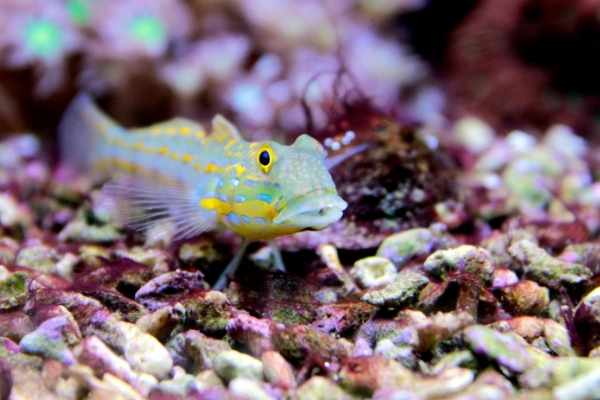
Note that the large rubble substrate in this picture is not ideal for the diamond goby, who will sift through the sand, if given the chance
It’s not very likely that you would have a saltwater aquarium without live rock or some other structure, but it is worth mentioning the importance of the structure for the natural behavior of the fish. If you can meet both of these conditions, you will likely be rewarded with a healthy, peaceful fish that will dig under the rock and sift through the sand, finding tiny morsels to snack on, while keeping things tidy and the top layers oxygenated.
Feeding the Diamond Goby
Watching the Diamond Goby forage in the sand and sift it through its mouth and gills is interesting and fun to watch. They are carnivorous fish that usually searches the sand bed for their meals. But do not rely on them to meet their own nutritional requirements in your tank without proper feeding. They are carnivorous and should accept live or frozen brine shrimp, mysis shrimp, live blackworms, and copepods, and other prepared marine foods, in addition to whatever meaty morsels they find while foraging in your sand bed.
It is also recommended that you take a moment to make sure they’re getting enough food to eat. Given the fact that they live on the bottom and that they are very peaceful, it is possible that the greedier fish in your tank swoop up all the food before they get their share. If that’s the case, you may want to do some directly targeted feeding, as well. Starvation is sometimes reported in this species.
They are also reported to eat some smaller bristleworms.
Compatibility
Orange spotted gobies are reef safe and will leave your corals and other invertebrates alone. They are also peaceful community fish that will get along with the other non-aggressive saltwater fish in your aquarium. There are two conditions under which they are known to predictably display aggression:
- When kept in the same aquarium with other Diamond gobies (that are not an established or mated pair), or sleeper gobies
- Defending their territory against encroachers.
Species to avoid keeping with the Diamond Watchman Goby
There is likely no surprise to this advice, but don’t keep the Orange spotted goby with any aggressive or predatory fish that would consider them dinner, or even a light snack. A few easy examples of fish to avoid keeping concurrently would be Lionfishes, Groupers, Picasso Triggerfishes.
It is advised not to keep them with semi-aggressive species like the more pugnacious dottybacks, damselfishes, etc.,
Good pairings
Due to the peaceful disposition of the Diamond Sleeper Goby, there is actually a lot of suitable pairing, but here are a few suggestions to get you started: Firefish gobies, Lawnmower blennies, Marine Betta, Pajama cardinalfish, Neon goby…and on, and on.
That is not an exhaustive list, just representative of a few good choices.
Breeding and reproduction of the Diamond Watchman Goby
While you should expect to see aggression if you mix two or more non-bonded Diamond gobies in the same tank, it is possible to establish pairs or to purchase previously bonded pairs. They share a burrow and will lay their eggs inside the burrow.
The male will guard the eggs for ~3-4 days until the larvae emerge after lights-out.
Diamond goby larvae are phototropic and can be attracted to the surface with a flashlight or captured with a larval snagger. The fry are fragile and difficult to rear, even by saltwater fish standards.
Check out this site for more information about breeding them.
Diamond Watchman Goby hiding
The Diamond goby is a digger and likes to spend time in their burrow. At night, or when spawning (if you have a pair) they will even cover up the entrance. Don’t panic if you don’t see them for a few days; this is normal behavior for this species.
A bit about their common names
It is interesting to see that this awesome fish has several very different common names–but why do they have ‘Watchman’ and ‘Sleeper’ middle names? I don’t have great answers to these questions, but I did look them up.
Why are they named “sleeper” gobies?
There isn’t a lot of great mystery or intrigue here, but according to Encyclopedia Britannica, they’re called sleepers simply because they peacefully exist on the sandy floor.
Why are they called “watchman” gobies
The tag Watchman is a little more straightforward and is thought to be associated with the fact that some goby species have a symbiotic relationship with certain shrimp, like the Pistol shrimp, that have poor eyesight. The gobies literally do keep watch. It is a bit of a misnomer in this case since this sand-sifting species isn’t generally the type to pair up with a shrimp.
Here’s my reaction to this:
Orange spotted goby cost and for sale
The Orange spotted goby is generally in the $30-$45 price range, from what I’ve seen. They are not one of the most popularly imported saltwater fish species, so you may not see them routinely in your local fish store. They are commonly purchased enough to be relatively available on the major online retailers.
Conclusions
The Diamond goby is a great saltwater fish for any community reef aquarium with a deep sand bed (that doesn’t already have a burrowing resident). They are energetic, amusing to watch, and full of personality. Peaceful in nature, and reef safe, they are compatible with many of the most popular fish, corals, and invertebrates. They can get to be a decent size, when fully-grown, but don’t require a lot of swimming room. Rather, the most important care aspect is ensuring enough sandy real estate for them to call home.
What to read next
If you are looking for saltwater fish with big personalities and behaviors that are fun to watch, check out these other great species:
If you’re just starting out, here is a great resource to plan out the set up of your saltwater aquarium
For more information
If you want to learn more about the Orange spotted goby, check out this video:
References
Michael, Scott W. Marine Fishes: 500+ Essential-to-Know Aquarium Species. TFH Publications. Neptune City, NJ: 2001.
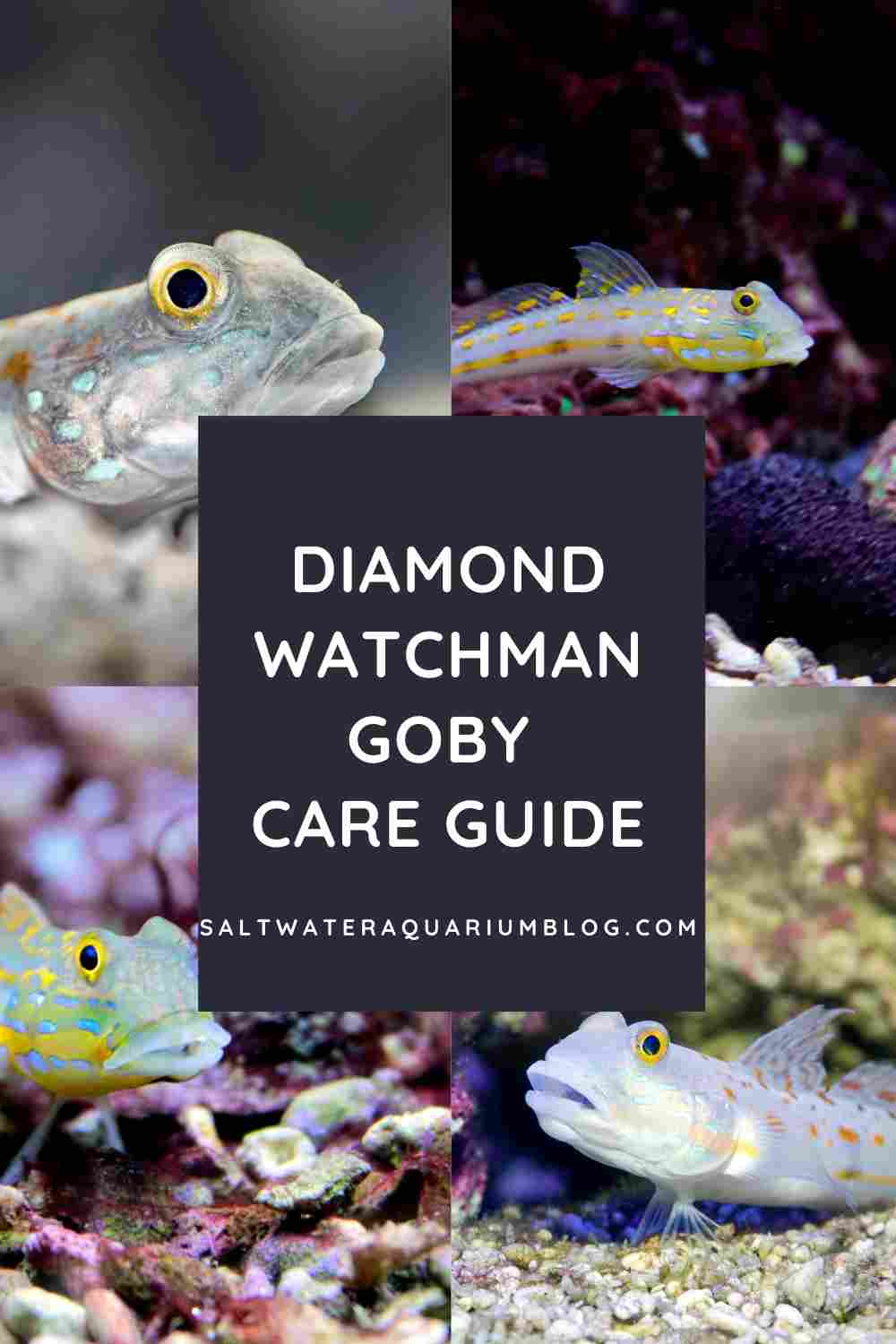
Pin this on Pinterest
[ad_2]
Source link

